Have you been searching for the best way to compete in the new frontier of web design? Do you need to stand apart from your competitors in a big and bold way? Well, here’s your answer: motion design.
Motion design refers to anything from an animated logo to subtle motion on a website. But why is it worth investing in? Let’s take a look at how custom animation can yield much stronger ROI than static graphic design or leveraging stock animations.
Motion is Memorable
People are more likely to remember something that moves. People spend 2.6 times longer on webpages that have videos than ones that don’t. Motion design is ideal for marketing because it’s design + messaging + memorable movement, all in one piece of content. It’s a golden trifecta for a brand’s first impression. Think kinetic typography in hero zones, micro-interactions in UI and CTA buttons, explaining your tagline through an animated logo, or even a full segmented-explainer-video-landing-page experience. These motion integrations will not only catch a user’s eye, but sustain their attention on page long enough to peak interest.
The PLASTICS Industry Association turned to Bluetext to develop a full new brand system for their triennial trade show, NPE®. Within the new CVI, Bluetext developed a logo animation that could be incorporated into the new video assets and onto the new website. The logo, which leverages a globe design, animates each individual element of the globe to form into one, highlighting how NPE brings together plastic industry professionals from around the globe.
Motion Helps Tell Your Brand Story
While, yes, motion design gets (and keeps) attention, it also tells a story. If a user is watching and absorbing, they are tangibly engaging in your message. A static design doesn’t allow you to express your brand to its fullest potential.
For SonicWall, Bluetext incorporated a parallax effect that follows the user’s cursor as they move it across the page. This subtle movement brings the visuals to life, making the focal point really feel like it’s floating, or in the case of SonicWall, boundless. SonicWall used this effect to bring their metaphor of Boundless Cybersecurity to life and fully engage users in a big way.
Motion Brings Your Brand to a New Level
Motion design brings your brand to life in ways you could never imagine. Take static brand elements and transform them into tools for storytelling. When Appgate turned to Bluetext to establish a new brand and help bring the company to market, we took their new brand and created a 30-second product video marked exclusively with animated brand elements. It was memorable, clean, and told the story of who Appgate is and where they are heading. Appgate truly got the most out of motion design by also integrating subtle animation into their website. Pairing a memorable and exciting video with recognizable animated elements on the website truly reinforces the branding and creates a memorable experience for the user.
Interested in getting the most out of motion? Contact Bluetext to learn more about our video and animation services.
You’ve spent months working with a video design & production company to write the perfect script, find the right voice-over actor, polish your storyboard, and so much more. Now, you have a video that captures your brand essence and you want users to see it. So what’s the best way to get impressions on your video? As a premier video design & production company, we know there are countless options for getting your video in front of users.
With over 2 billion users and more than a billion hours of videos watched daily, YouTube is one of the best ways to ensure your target audience finds the video content you’ve produced. To truly understand just how powerful YouTube can be as a platform, it’s important to understand the basics. Keep reading to learn more about YouTube advertising and it’s different kinds of ad formats.
What Type of YouTube Ads are There?
YouTube Ads are controlled through the Google Ads platform, allowing advertisers to maximize their reach. Through YouTube Ads, you can decide whether you want your video to appear before, during, or after the video a user is watching. The six primary ways you can advertise through YouTube are:
- Skippable in-stream ads
- Non-skippable in-stream ads
- Video discovery ads
- Bumper ads
- Masthead ads
- Outstream Ads
Let’s take a look at each one.
Skippable In-Stream Ads
If your goal is to drive website traffic and/or conversions, this is a great option for you.
Skippable video ads play before, during, or after a video and users have the option to skip the ad after five seconds. As such, advertisers are only charged when a viewer watches 30 seconds of the video (or the full duration of the video if it’s shorter than 30 seconds) or interacts with the video. With this in mind, it’s important to keep your ad short, sweet and to the point. Don’t bury your main points 25 seconds in the video, but rather front load with interesting content that hooks a user and encourages that conversion action. Alongside skippable video ads, advertisers have the option to display a companion banner in the top right and a video overlay CTA button in the left. Needless to say, skippable video ads can be great for a lot of reasons.
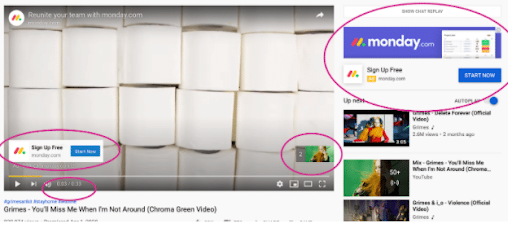
Non-Skippable In-Stream Ads
Given the nature of non-skippable in-stream ads, this is a great format if you’re aiming for a lift in brand awareness. With 76% of users skipping ads out of habit, it can be worthwhile to run ads that don’t have an option to be skipped. However, with non-skippable ads, you need to be confident that your video is strong enough to hold your audience’s attention for the full 15 seconds. Given that viewers have to watch the full video, these ads typically have higher CPMs than other formats on YouTube.
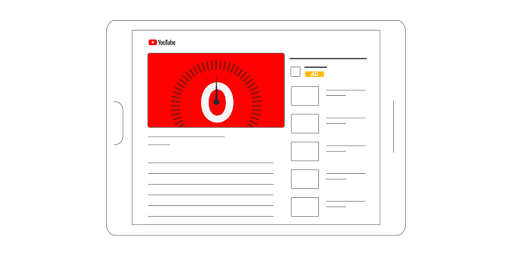
Video Discovery Ads
Video Discovery ads are best for product and brand consideration. Just like Google paid search ads, YouTube Discovery Ads display alongside organic YouTube search results. As a more native approach, if your video appears relevant to users, people are more likely to watch it. Alongside a thumbnail of the video, these ads allow for three lines of text to help provide users with more context and information. The text opportunity is great, because it ensures that a user consumes some brand messaging even if the video isn’t played. Furthermore, in the best case scenario, the description text further encourages the video play action, and eventually results in a lead or conversion.
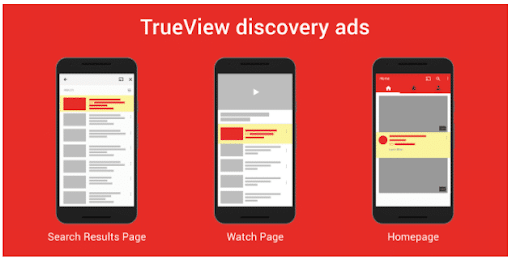
Bumper Video Ads
Are you looking to capture viewers with a short, memorable message? Then bumper ads are for you! At only 6 seconds, bumper ads are a quick, snappy way to leave viewers wanting more. Billed on a CPM basis, these ads are best for building brand awareness, given that they are also non-skippable.
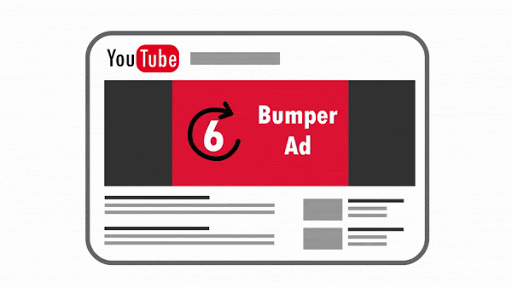
Masthead Ads
Masthead ads are a fantastic way to drive awareness for a new product, service, or event for a short period of time (i.e. a trade show). While most YouTube ads are purchased through the Google Ads auction, masthead ads are bought on a reservation basis. By buying on a reservation basis, masthead ads give you more control over your budget (buy impressions at a fixed rate), greater visibility (guarantee the placement of your ad), and better brand awareness (reach a wide audience).

Outstream Ads
Outstream ads are another great tactic for boosting brand awareness and bringing users to your site. With over 40% of YouTube viewers watching content on their mobile devices, a mobile-first ad campaign is a smart approach. Outstream ads, for example, are mobile-only and play on partner sites and apps outside of YouTube. While this might seem counterintuitive at first, this actually allows advertisers to expand their reach to publishers such as CNN and Forbes. In addition, users are more likely to view outstream video ads by over 25% when compared to instream ads.

Knowing that there are so many options for YouTube ads, it can sometimes be overwhelming to know what format to select. It’s important to start with your goal, and work backward from there. Better yet, consult a digital marketing agency for advice on the best ad format and strategy for your business. If you’re interested in working with a video design & production company to create your next video or need help figuring out how to promote your videos, contact us here!
Given the speed at which news is consumed today, timing is everything. Latching onto a rapidly developing news cycle is a great way to gain visibility for your brand, establish thought leadership on a topic and build relationships with reporters. Rapid response, or newsjacking, opportunities are when brands capitalize on breaking news to provide relevant commentary on the story while drawing attention to their own content.

As brand storytellers, we’re scanning the news daily for what’s happening in the industry, what brands are standing out, how our clients are showing up and more. Thus, implementing a rapid response strategy during your daily news scans is easy, time-efficient and can be very fruitful. However, there are a few things to be wary of, including sensitivities around the news, reaction time and offering valuable insights.
Read the Room
Not every breaking news story needs commentary. Consider the sensitivities around the developing story, read the room and evaluate if a comms strategy is necessary around this cycle. If yes, then designate who your spokesperson will be and develop your commentary.
Amid tragedy at a global scale, like social unrest, natural disasters or pandemic, it is best advised to redirect external communications to focus on internal messaging and making sure employees feel supported. Exploiting tragedy and proactively telling a reporter how a company’s software product might have altered a tragic situation can be perceived as insensitive and will put your brand in a negative light.
A prime newsjacking market is cybersecurity. There are countless hacks that offer opportunities for cybersecurity firms to comment on topics like how the hack occurred, how that kind of hack or bad actor will evolve throughout the year and beyond, background on the hack or bad actor, what cybersecurity protocols can be implemented to prevent the hack from occurring again and more. But the noisier the market (and there are thousands of cybersecurity vendors with something to say), the more you will have to carve out a defined lane and message that reporters will find of value.
Timing Is Crucial
News comes and goes fast. Rapid response opportunities work best when you’re the hare, not the tortoise. In your daily scans, once you see a trending piece or developing piece and think that news cycle will pick up, get ahead — reach out to your spokesperson, pick their brain about how the story will develop, compile their thoughts into a pitch and ship it off to relevant reporters. From there, wait for the story to develop and see if the reporter has any other questions.

Yes, and ?
While timing is crucial in rapid response opportunities, it isn’t everything. Messaging is just as important. It does help to be the first to comment, but other brands won’t be far behind, and if your messaging does not add value to the conversation, it will not be included. On top of that, given the opportunity is industry-wide, keep the commentary broadly applicable but nuanced enough to stand out. This is not the time to gush about your company and the latest products.
There is a time and place for everything. While we as communicators want to jump on as many opportunities as they come, we need to be cautious about the ever-changing news landscape, the sensitivities of the world and the reputational risk that comes with it.
To learn more about how Bluetext can improve your newsjacking processes and timing, contact us today.
Picture this: You’re a cybersecurity expert with a next-generation product or service, and you’re looking for a way to get your message into the market uniquely. The industry landscape is crowded with companies with similar offerings and limited ways to stand out. You’ve been researching for hours and finally come across the perfect blog post – one about why brand storytelling is critical in cybersecurity (hint: you’re reading it). Now that you’ve found a blog post that answers your branding questions, you’re wondering where to find a cybersecurity marketing agency; in that case, I have some good news for you.
Sit back, enjoy a warm cup of coffee, and keep reading to learn more about the importance of brand storytelling through some of our favorite examples in cybersecurity.
Why Is Brand Storytelling in Cybersecurity Important?
The cybersecurity market is growing by approximately 10% every year. As a cybersecurity marketing firm, Bluetext has witnessed this growth and know it’s becoming harder to stand out in the cyber arena. These days, saying you solve your customers’ problems, and that your solutions are the best, simply isn’t enough. B2B buyers are tired of the same experience and are looking for authenticity and some sort of a connection. Even in a highly technical industry, it’s important to recognize your customers are still human! This is where brand storytelling comes in to help. Stories are an incredibly powerful tool in human connection and research shows the human brain positively responds to the impact of stories. Reading, seeing, and hearing a story is a way for users to enter the experience and connect with the subject of the story. By connecting with a story, user’s will pay attention longer, will want to learn more, and will be more trusting of your brand.
By instilling trust with storytelling, over 50% of B2B buyers are more likely to consider making a purchase, over 40% are more likely to share that story, and over 15% are more likely to buy a product/service immediately.
So now that we know why brand storytelling is important, let’s take a look at some of our favorite examples of brand storytelling in cybersecurity.
SonicWall
When SonicWall was looking for a cybersecurity marketing firm, they approached Bluetext to help them communicate their unparalleled business values across a variety of industries. Knowing the importance of standing out, Bluetext and SonicWall worked together to create the boundless campaign. The campaign was focused on floating imagery, which served to visualize the liberating feeling of breaking free from cyber threats. The campaign ads depict a series of end users, set in their specific industry. This creates a connection and familiarity with someone within that industry. Imagine seeing someone just like you, in the same industry and roles, facing the same challenges and use cases. This person was liberated from traditional cyber restraints by SonicWall, just as you could be.
To further bring the boundless story to life, Bluetext and SonicWall worked together to promote SonicWall’s Boundless 2020 Virtual event. In the end, this event ended up as the largest virtual event in SonicWall history and drove a 135% increase in attendance over their previous events.
HP
Hewlett Packard’s “The Wolf” campaign is one we often refer to as a masterful example of a company turning a mundane topic into a captivating story. Over the course of this series, Christian Slater infiltrates a company from the mailroom to the boardroom and exposes poorly secured devices on the company’s network. By creating this series with all of the components of a Hollywood box office hit, HP was able to effectively educate users on the importance of device security.
Norton
Another great example of brand storytelling is Norton’s The Most Dangerous Town on the Internet. In short, to quote the film, they visited “some of the most dangerous places on the internet to find out where cybercrime goes to hide.” In the film, the documentarians are able to interview small-time scammers and well-known cybercriminals who’ve infiltrated Google, the US Army, NASA, and more. By creating this documentary, Norton wanted to share an honest look at data havens and the secrets they hide. The authenticity shines through as a refreshing take on cybercrime that not many competitors are willing to share. With over 6 million views on YouTube and awards from Cannes, it’s safe to say this story got the brand’s message across. The story is dark, ghastly, brutally candid, and impossible to forget.

To help create a strong connection with users, as a top brand development agency, we’ve worked with many cybersecurity firms to help them tell their stories in a unique and captivating way. These stories have helped demonstrate that their businesses aren’t just faceless entities; they’re real people working to solve real problems.
Are you interested in working with a top cybersecurity marketing agency to help tell your story? Contact Us!
Developing an effective Business to Government (B2G) marketing strategy to reach decision-makers in the public sector requires a handful of marketing tactics, perhaps the most impactful of which is a well-founded public relations program. However, before diving headfirst into a multi-faceted digital marketing campaign, it is critical to recognize that government agencies have many different challenges than private-sector organizations, and therefore doing business with these agencies requires a much more tailored approach.
Many government agencies, especially at the state and local level, work in silos — meaning that it is often difficult for these agencies to get the technology, resources and expertise they need to efficiently serve their citizens. One recent survey found that more than 80% of U.S. government officials feel their agency is technologically behind where it needs to be in order to handle the new challenges it faces.
In order to effectively engage federal, state, and/or local government agencies, businesses must first understand the perspectives and challenges those entities face and where to best reach them. Once you’ve gotten a grasp on the barriers and challenges agencies face in working with you, you can begin to build out a content strategy that addresses those challenges and helps you get a foot in the door. Luckily, experienced PR agencies are well-versed in how to help cultivate messaging that will resonate with both government-oriented media outlets as well as the decision-makers themselves.

Target content at agency decision-makers
In order to speak the language of government decision-makers, contractors need to develop content that speaks directly to agency decision-maker pain-points. Government agency contractors must also understand that government decision-makers are driven by different motivators than in an enterprise environment.
Everything does not necessarily revolve around profits for them, therefore content must speak to decision-makers’ primary pain points. Messages that pivot away from the bottom-line, and refocus on unique challenges of the targeted government agencies will earn attention. Timing is also critical — organizations must hit decision-makers at the right time in the procurement process with content and knowledge that stands out in what is a very commoditized market where government-contractor and tech company messaging all seem to blur together.

Establish expertise in your market category
Understanding your organization’s existing and aspirational market footprint is the first step in carving out a niche that you can own as a thought leader. For example, there are countless cybersecurity vendors in the public sector, all of which sell a variety of security solutions that promise relatively similar results e.g. “visibility, detection, the response against evolving threats.” To gain real traction as a thought leader in the public sector, you must drill down into your specific two to three areas of expertise.
Once you’ve laser-focused on the arena in which you’re planning to own, a PR team of consultants can help you build out an editorial calendar of topics and discussions you want to participate in to align your content with quarterly and annual sales goals. This process of self-vetting and prioritizing will result in an organized and unified message about your company and its areas of knowledge when featured in editorial and published content.

Identify and prioritize your future-oriented solutions
Many organizations in the B2G marketplace make the mistake of getting stuck in the ruts in which they have always operated. They may have one or two solutions that sell well to their target audiences, so they become complacent in innovating new product lines or messaging.
For example, in the 1960s and 70s tech-giant, IBM’s top-grossing product was a typewriter. It may have seemed safe at the time to streamline their operations and prioritize their top-grossing product as opposed to developing and pitching new products and technologies to their customers. With the benefit of time we now realize that typewriters were soon made obsolete by keyboard computers, meaning that if IBM would have centered its business model around typewriters, they would not be the tech giant with a global footprint they have today.
All this goes to say, it is imperative that businesses selling to government agencies consider that their top-grossing products may soon be eclipsed by newer, faster, stronger, and more advanced solutions. Keeping an eye and ear toward future government agency needs will help organizations stay on the cutting edge of tech demands in government. Cultivating relevant, thought-provoking content that stands out to public sector decision-makers is one of the primary in-roads to conducting business with the government. If you want to learn more about how we have driven successful B2G content programs through PR and digital campaigns, get in touch with Bluetext.
The past couple of years has ushered in a number of changes for the marketing strategies of major defense and global technology brands serving the federal government. As a trusted marketing and PR agency to B2G clients, Bluetext has seen a massive shift towards digital marketing initiatives in a short amount of time. Once upon a time, government defense and technology marketing was concentrated in stacks of Federal IT and Defense magazines. These were reams of tangible, tactile publications that B2G paid big bucks to advertise in. However, the recent shift toward digital advertising has been embraced across industries– government agencies included.

The precipitous decline in print publications, combined with the impact of COVID-19 and budget cuts on the federal agency buyer’s ability to travel to attend industry conferences, trade shows and seminars has flipped traditional marketing models on their head. The resulting void of strong physical content and branding has led to an increased thirst for more readily accessible “premium” content—white papers, e-books, survey reports and other in-depth materials that can be indispensable for government decision-makers. Digital content marketing has been embraced as a cost-effective and more accessible means of reaching target government buyers.

Previously, B2G companies could load up on traditional marketing to push government contracting vehicles—their IDIQs, GWACs and GSA Schedules – especially at the end of the federal buying season. There was once a time and a place for that – but no more. Marketing is now forever changed thanks to Al Gore – or whoever invented the internet. Digital marketing initiatives have created opportunities to distribute content marketing at any time and any place.
This opens a door of opportunities for many small government contracting agencies, as the playing field has been leveled by online content. As a result, companies have evolved their digital marketing strategies to consider government buyers as real buyers just like you and I, involved to varying degrees in researching, influencing and taking themselves 75 percent through a buying process to ultimately select a solution that your company – and your 10 largest competitors – all provide.

This is why it is critical to target your marketing with premium content to specific and very real buyer personas. You need to put yourselves in their shoes to differentiate your brand and fill that void with contextually relevant content before your competitors do. No matter who that buyer is, they are all facing the same quandaries:
- I have a problem, but I don’t know what the solution is.
- I know what some solutions are, but I don’t know which one is best for me.
- I know which solution I want, but I don’t know who to buy it from.
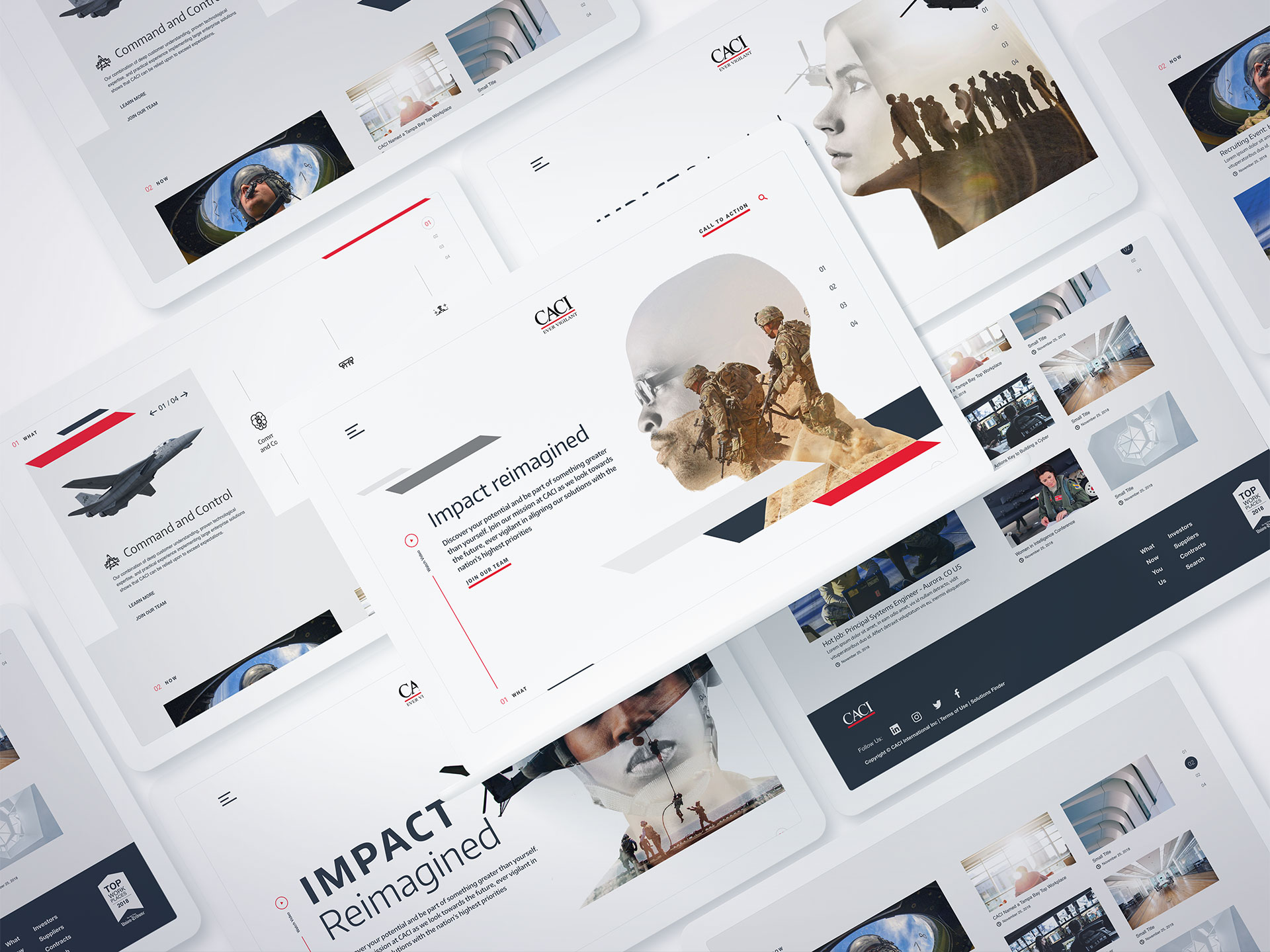
The best way to answer all of these questions is with content. While the solution seems simple, many companies do not yet have mature content marketing strategies and lack the in-house resources needed to generate enough thoughtful, relevant content to drive engagement that results in traction for their brands in this market. The other challenge is harnessing the thought leadership of their subject matter experts. The people inside their company who have the expertise on issues most relevant to your target audience often do not have the time or have not been engaged to contribute content on a regular basis. As a result, marketers are struggling not only to develop the editorial calendar but more importantly the content itself.
Digital marketing agencies acknowledge that the secret to successful content marketing is two-fold. Firstly, it requires thoughtful and relevant content to your target personas, but also memorable brand application. Put yourself in the shoes of a government buyer evaluating you and your 10 closest competitors for a new contract. Your company may have the most powerful piece of thought leadership out there, but if it’s not branded or visually appealing it will likely get lost in the number of companies and content being considered. The last thing you want is to invest time and energy in an in-depth whitepaper, but have the reader not even remember which company it came from. Well-branded collateral allows you to layout content strategically, emphasize the key points and create brand association with the powerful words on the page.
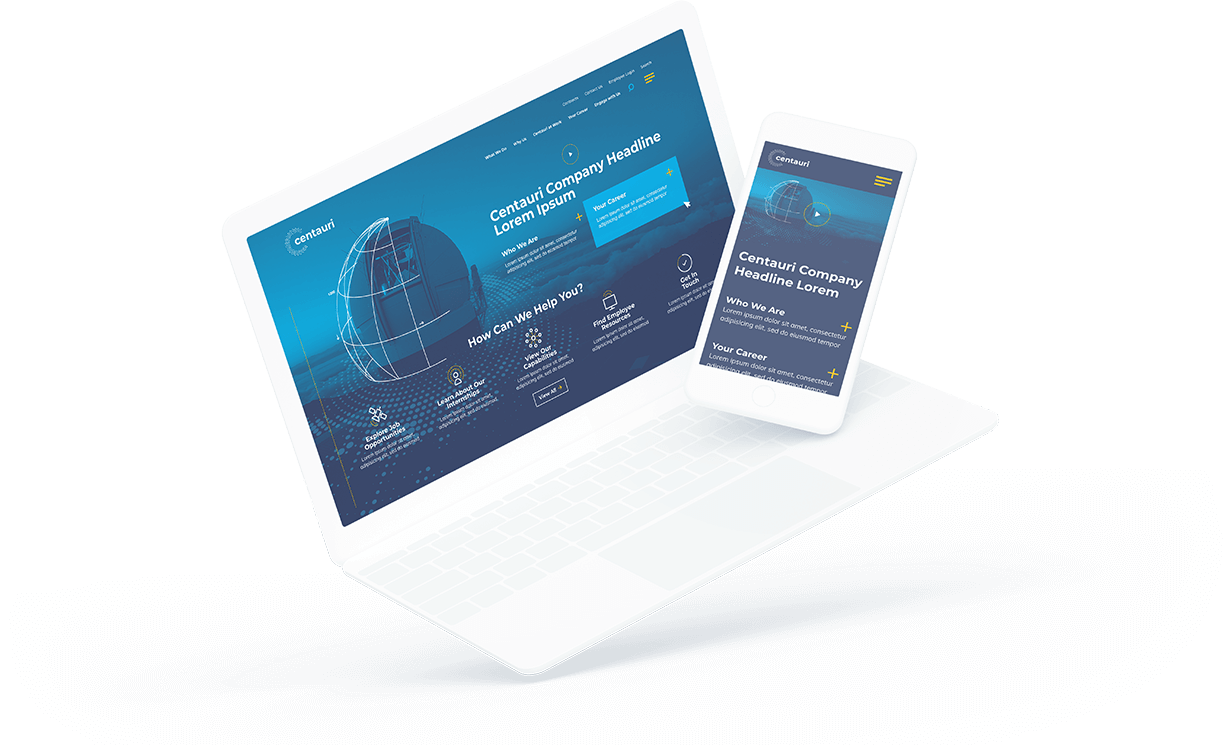
It’s no secret that a lot of successful marketers are turning to agencies to overcome this very challenge. When they do, they realize very quickly that a digital marketing agency can capture more eyeballs – and drive much more significant and targeted brand engagement—by empowering them to become masters of their own content for far less than what they used to spend on traditional ads in all of those long-gone publications. They all once had their time and place – and so will your brand if you continue to allow your competitors to outmarket you and find a cozy place for their content in the minds of your buyer.
Contact us to discover the ways Bluetext can optimize your digital content marketing strategy.
2020 will forever mark a significant milestone in remote work practices. To comply with COVID-19 safety protocols many companies have closed or limited office capacity and enabled their workforce to work remotely. There is a significant change in everyday work practices, but even more significant change in large industry events from trade shows, networking events, and conferences. While industry events as we know them are not yet possible, business must go on. Luckily, digital-based agencies such as Bluetext, have been hard at work to innovate solutions that can replicate the in-person experience as much as possible with virtual events.
Virtual events will become a universal industry standard in the future, regardless of when large gatherings become safely possible again. Hosting a virtual event eliminates the time and cost associated with work travel and allows flexibility to attend event sessions while keeping up with the normal day to day operations. Virtual events allow employees or colleagues from anywhere in the world to easily join from the comfort of their own home or office and can choose to be present at only event sessions relevant to them and their interests. Rather than having your whole team out for three days, there is the flexibility to attend select sessions for a couple of hours at a time.
If your company is considering hosting a virtual event, there’s a couple of things to consider first. After the success of Citrix Bootcamp and SonicWall Boundless 2020, Bluetext has rounded up their top tips for the first step of any virtual event: registration.
Ace the Virtual Event Invite
One of the first things to consider with any event is: Who is the audience? Is this a trade show for a number of different companies? An employee only training? Select clientele? A virtual event marketing agency will assist with the outreach to attendees, whether that strategy is based on a specific email list or advertised publicly. From email nurture campaigns to targeted paid advertising, the options are endless for inviting attendees. Based on who the target audience is, a digital marketing agency can prescribe the right strategy for your company and design promotional assets to get people interested in the virtual event.
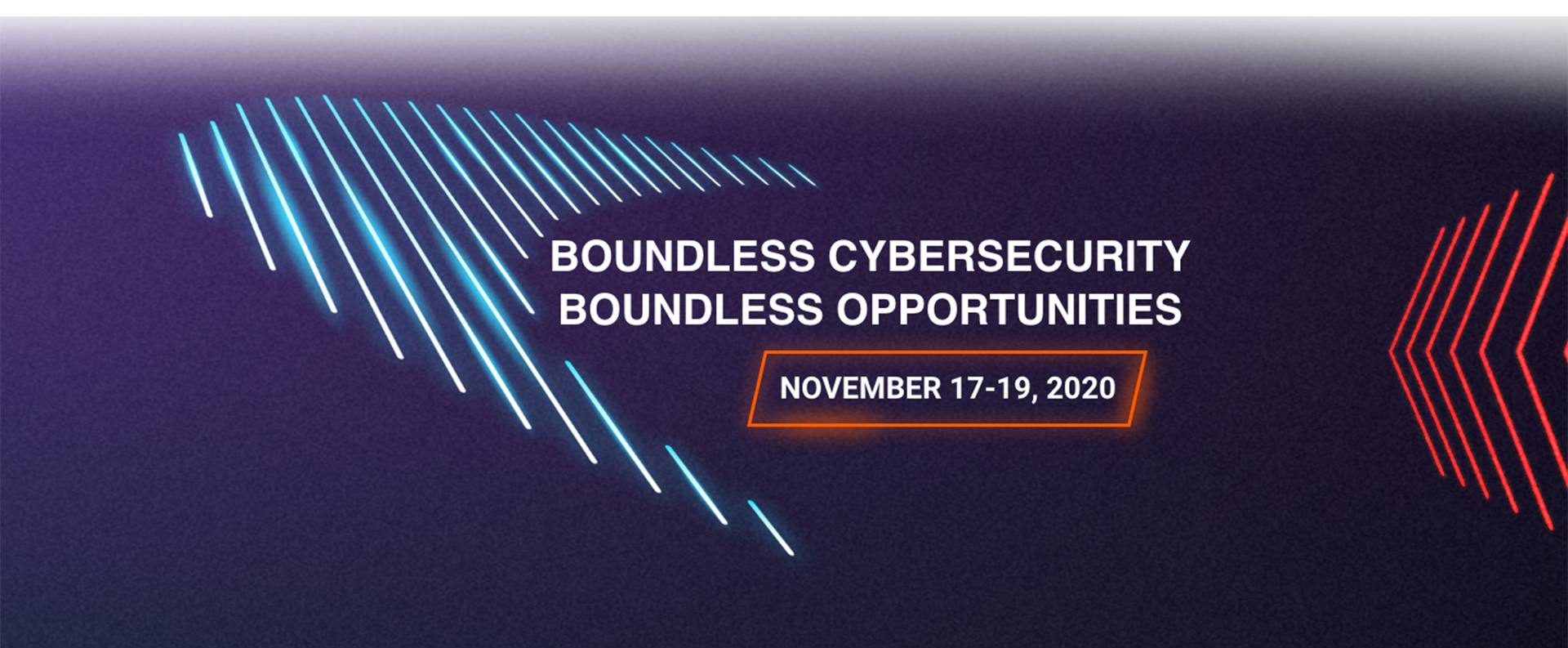
Load Up the Landing Page
Once you’ve sent out invites or promotional messages, attendees will need a place to RSVP. Just like a traditional in-person event, a headcount of attendees is needed to properly plan and test for specific traffic levels. Registration numbers are also a great KPI to measure event success. To fully close the conversion, the landing page for the virtual event must be clear, concise and enticing. There’s no formula for the perfect virtual event registration page, but at Bluetext we recommend the following components:
- A concise listing of event details (date, time, time zone, etc.)
- Spotlight of the top event sessions to get users interested
- A sizzle reel to showcase the event highlights in a minute
- A clear and easy to find the registration form
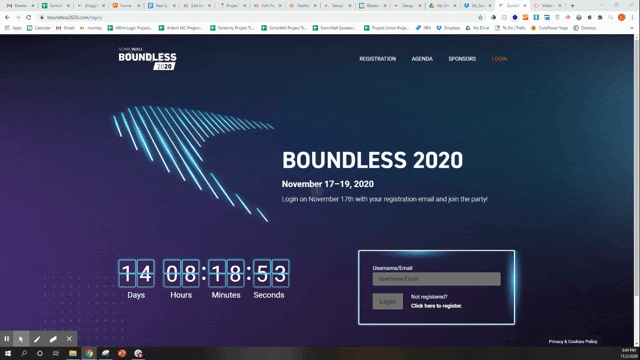
Who’s On the List?
A key component to consider with virtual event registration is registration security. Will there be proprietary information discussed at the event? Will sessions be targeted at only your employees to introduce not in market products or strategies? If so, you may want to consider white-listing your company’s email domain. If the event is centered around internal strategies and training, you may want to also black-list the email domains of your top competitors. Depending on the size and subject matter of the event, it may also be important to reinforce security by black-listing personal email addresses and ensuring all attendees are relevant business partners and colleagues.
Always Say Thank You!
Once a user has found your enticing landing page and successfully registered for your virtual event, don’t let the excitement end there. Be sure to send them an equally interesting thank you page. In our virtual event marketing experience at Bluetext, we have found that dynamic countdown clocks are a great way to get users excited about the event. A great thank you page may also want to link out to event FAQs, or highlight a special session to look forward to.
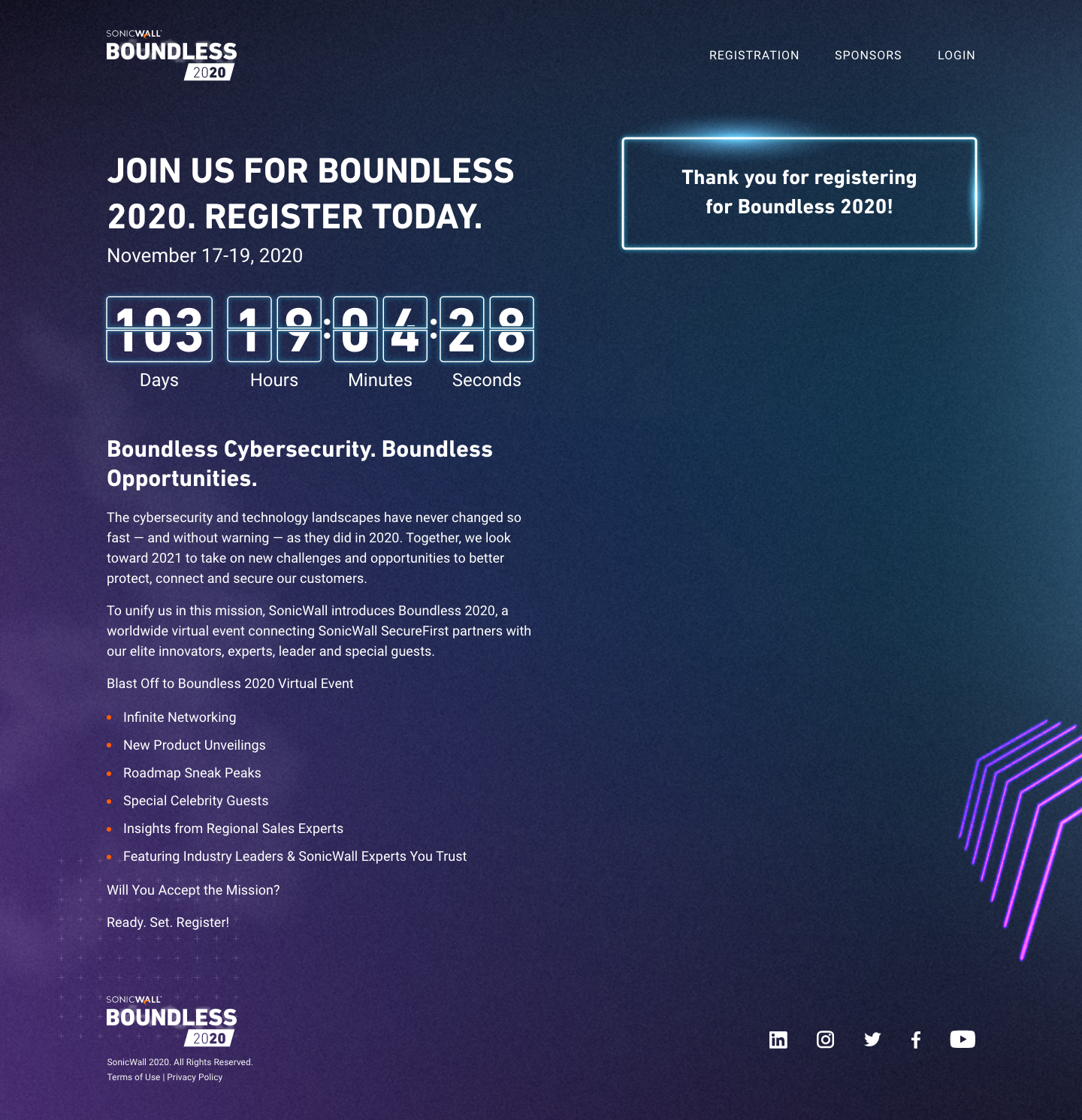
Reminder Emails They’ll Want to Read
Once a user is registered don’t let your virtual event fall off the radar. Use the registration email list to trigger a nurture email campaign that can send additional event details, reminders, and more! A full event agenda can be overwhelming to a user two months out but would be useful when they’re blocking off their calendar a week or so in advance. It’s always a best practice to remind users a week, a day, and an hour in advance of the date. Check out the recent SonicWall Boundless 2020 virtual email for some inspiration on event teasers and reminders.
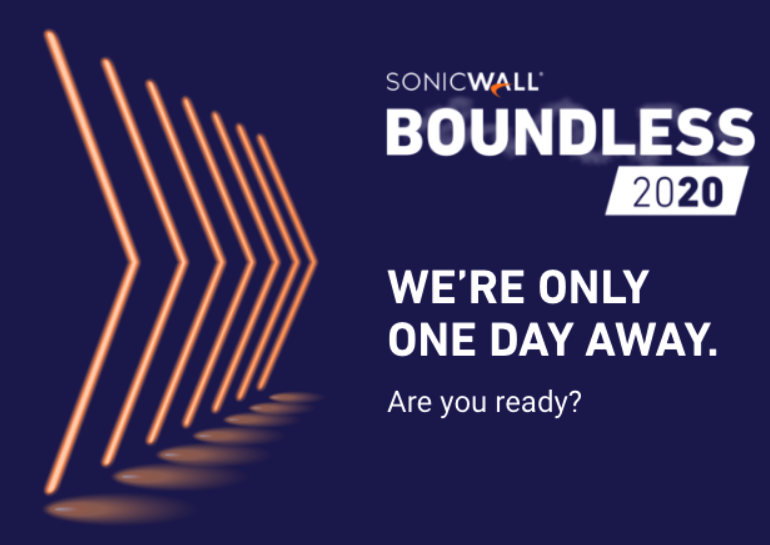
A Content-First Approach.
Enterprise-level website redesigns are exciting but can be overwhelming. There are countless variables to consider – from appeasing stakeholders and business units, to ensuring an intuitive customer-first user experience that aligns with company-defined website goals and KPIs. One of the most important considerations to think about before embarking on a large-scale website redesign is content. A beautiful, new design is worthless without good content. Users want (and expect) to get value from every website they visit, and that value comes from the content. But at the enterprise level, understanding and applying a smart content strategy can be a daunting and difficult task. Luckily, the content marketing experts at Bluetext are here to help.

6 Key Content Strategy Steps to Take Before Design:
1. Conduct a Content Audit
Before investing in a big website redesign, there needs to be a thorough discovery phase that involves conducting a ROT (redundant, outdated, trivial) analysis to understand the current state of content, identify legacy content that should be removed, any gaps in the content, and ultimately understand if the current content aligns with the redesign goals. Bluetext has industry-leading crawling and scraping tools, such as Screaming Frog, to automate and provide this data. Competitive analysis and market research are also critical steps to gaining insight into how other players in the industry are applying content strategy. Some specific aspects to take note of include:
- Page structure and content flow
- Calls to actions
- Navigation/sitemap
- Linking
- Relevance to the user
- Language/tone of voice
- SEO
- Multi-media usage
2. Establish Website Goals & KPIs
Out with the old and in with the new! In order to create a successful new website, you need to identify the current weaknesses and where improvements can be made. Like any major business venture, it must begin with setting realistic goals. Be sure to benchmark against tactics and KPIs (key performance indicators) to measure the success of those goals. A flashy new website might look nice, but ultimately your stakeholders want to see quantifiable success. It’s important to audit what content is working and has high conversions. Leverage Google Analytics to see what the most trafficked pages are and what users are searching for. Setting up click tracking and heat mapping on your site provides data to help understand user behavior and guide decisions. An example of a website redesign goal mapped to tactics and KPIs may look like this:
-
- Goal: Streamline Product Page Content
- Onsite Tactics: Design product template based on journey-oriented content strategy. Reduce content to highlight the most important and relevant selling points/CTAs.
- KPIs:
- X% decrease in bounce rate on product pages
- X% increase on time on product pages
- X% increase on product page conversion rates
- Goal: Streamline Product Page Content
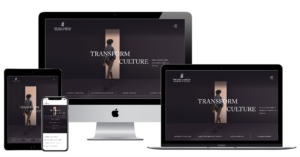
3. Build out Website Personas for Journey Mapping
Understanding the different personas using your website is pivotal because these users and their unique goals should inform the content requirements. For example, a large software company’s website will have multiple personas. One persona might be a new, less-informed user who is seeking a solution for a specific problem they have. Another persona may be a returning customer and therefore more educated. This informed user might be looking for product support or to try a free download of a new product.
These two users have very different needs for the website and therefore the way they navigate the site will be different, and the website content and design need to account for that. Understanding the goals of the various personas and the likely journey or path in how they use the site to achieve that goal directly impacts the content and the content hierarchy they should see.
4. Create Data-Driven Navigation
An intuitive site structure (displayed via the navigation) is integral to a great website. The navigation informs the user how the site is structured, and when done well, helps guide the user to the content they need to see. According to Sweor, “88% of online customers are less likely to return to a site after a bad experience.” Considering many customers rely on either search or the navigation to guide them, having an intuitive navigation that ensures every persona has a clear path to their destination is key. Think of your sitemap as a personal GPS through the sales funnel. It should route a user from a unique “Current Location” to the end goal of conversion. Analyze user-behavior data to better understand how different customers are using the navigation currently. Is there a significant difference between new and returning user behavior? Also, see if there are other ways customers are using the site that aren’t accounted for in the navigation that should be. Once a proposed sitemap/navigation is created, conduct usability testing to validate the new structure.
The goal of a good navigation system should be to get the user to the most relevant content as quickly and easily as possible. Much of this comes from smart design, but content plays a big role here, too. Use skimmable, digestible words that customers understand, not lengthy, internal company jargon. Users are quick to click, so using copy that resonates fast and leads the user to the right path will provide a better experience for them. This applies to content across all pages as well as navigation content. “Most of the time we don’t choose the best option—we choose the first reasonable option.” Don’t Make Me Think, Steve Krug.
There are only a few chances to convince the user that they can get to the content they need before they get frustrated, bounce, and look elsewhere at another site. As such, every piece of content needs to be thoughtful and intuitive.
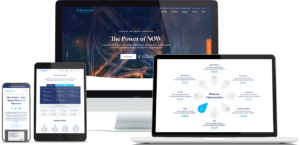
5. Define Goals for Each Page-Type/Template
At the enterprise level with hundreds of products and solutions spanning multiple business units, it becomes extremely difficult to give all the content the time and nurturing it needs. It becomes tempting to simply include everything as a “catch-all”, but this is a fast-track to overwhelming and losing user interest.
As mentioned previously, different personas require different content. Defining goals for each page-type/template helps focus the content to achieve that goal. Is the call to action driving a conversion for that goal? Are the proper users being driven to this page to achieve that goal? Do these page-specific goals align with the previously set redesign goals, tactics, and KPIs? Once goals are well-defined for each page-type/template, then the content requirements and hierarchy should be thought out accordingly.
6. Determine Content Requirements and Hierarchy
Now that page goals are defined, it’s time to determine content requirements and content flow. The content should be aligned with the goals of that page and when done right, will improve conversions. The order of the content displayed is important, as users skim and expect to see the most relevant content at the top. The perfect marriage of content and design always refers back to the goals and on-site tactics. Ensure the content drives the user to perform the goal of that page (whether it’s downloading a free trial, contacting sales, submitting a form, etc.). Once content requirements and hierarchy are well defined, then it’s finally time for design!
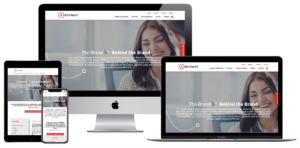
Understanding and planning out content needs early-on makes the design process more efficient and effective. That being said, the biggest ROI for smart content strategy will be proven after launch when those previously defined KPIs improve.
Looking to get started on your next big website redesign? The experts at Bluetext are ready to help!
The recent COVID-19 outbreak has had ripple effects across almost every industry. Around the world, the global pandemic has altered the way we live, socialize and even conduct business. In this unprecedented scenario clouded with uncertainty we all, especially digital marketers, are wondering: What needs to change? And how drastically?
When it comes to search engine optimization strategies, digital marketing and content agencies are continually researching the latest trends and evolving best practices. In the current environment, the role of a top digital marketing agency is to keep a pulse on the present, while also looking forward to strategies that will drive long-term success. Here at Bluetext, our digital marketing analysts are harnessing a variety of tactics to support overall business goals and serve users the best we can during these uncertain times. Check out the top ways we’ve been monitoring and optimizing around current events.
Strength in Numbers
When in doubt, trust the data! Using top marketing analytical tools, such as SEMRush and Moz, one can track the aggregate behavior of online users. Gathering the most up to date data can be tricky, so don’t do it alone. The more expertise and tools, the better. Trust a marketing analytics agency to help break down the numbers into a comprehensible story of website traffic. Use professional tools, such as Google Analytics and Google Search Console, to monitor the recent fluctuations in your page traffic. Do a keyword analysis of your current keyword list to see if search volume has shifted. Google Trends page is a great tool to identify emerging patterns. Are there new phrases your customers are searching for? If the language has evolved, so should your SEO strategy. If you have chatbots for customer service transcripts, these can provide valuable insight into current needs.
In short, the data doesn’t lie. Businesses need to understand search traffic shifts to get as clear as possible a picture into whether to pivot your SEO strategy or not.
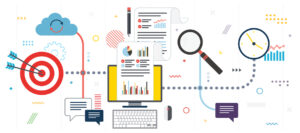
Content is King — Still
Ultimately any changes to your SEO strategy should be driven by your unique business needs. For example, a brick and mortar store will need to cater to how they can serve customers at home. If your business was already available online, you may be experiencing altered user behavior as people spend more time at home and online. Every business should ask: “Is the content relevant to current needs?” Your messages may need to shift in sensitivity to the current environment. A complete overhaul is not necessary, nor appropriate. However, if there are opportunities to generate new content that supports your users in a unique time, do so. And if your business is considered essential or has been significantly impacted, you should create a dedicated page to capture all relevant coronavirus traffic. Keep the page simple, focused and sensitive. Don’t try to provide the latest breaking news, but exactly what and how your company is doing. If your business has been minimally affected, perhaps there is an opportunity to contribute to emerging conversations. Exploding Topics is a valuable tool for up-to-date trends across search engines and social media mentions. At the end of the day, users are seeking timely and accurate information now and long after the dust has settled on this pandemic.
 Optimize Often
Optimize Often
Search engine optimization is never a “one and done” task. Any digital marketing strategy requires upkeep as is the nature of the evolving industry. Now, more than ever, flexibility is paramount to staying afloat. Be proactive, be vigilant. SEO strategy will need re-evaluation in the upcoming weeks and months. No one can predict how long the pandemic will last so you must be ready to pivot to any new or resurging customer needs.
In an unpredictable environment, one thing is certain: this is our new (remote) reality. Don’t expect old strategies to work as they once did, and don’t expect this shift to “blow over soon”. Your business should be prepared to remain relevant now more than ever. There will likely be long term implications in behaviors and business operations. Get behind the shifts now and flex your agility. It will pay off in your long term business health.
If you’re looking to partner with an agency to pivot your SEO strategy, let us know.
- The COVID-19 Pandemic has expanded the “stay at home” audience for B2C businesses.
- The consumer sector has seen changes in how audiences are reacting to content and consuming media.
- Capturing these audiences will require businesses to adapt content and tactics to the current climate.
Over the past few months, we have all adjusted to new living and working environments. This means varying working hours, virtual gatherings and different web surfing, streaming and social networking habits. These changes have shifted the traditional marketing audience profile.
If your business is B2C, you should be aware of these audience changes and adapt your marketing tactics to keep up with the current trends. Here are a few ways that you can make sure your message doesn’t fall flat with the new “stay at home” audience.

The concept of a “stay at home” audience is not new. The number of remote workers in the U.S. economy has grown steadily over the past several years. Online graduate and undergraduate programs have grown more popular, and the number of parents staying home with new children was rising even before the pandemic hit. Not to mention the number of companies adopting a digital-first approach and offering remote positions. However, this pandemic has rapidly expanded the “stay at home” audience beyond traditional groups.
It is crucial that all businesses hit the right tone with messaging during the pandemic. This is a different, uncertain and potentially difficult time for everyone, so brands should adjust their tone to one of encouragement and solidarity. No one wants to see pure sales messages at this time. Potential customers need to feel supported and confident that every purchase is essential for them.
Content
There are a few ways that businesses can cater to new stay at home audiences, one of which is content. One way to show solidarity with customers that may be struggling is by providing giveaways or special promotions that you normally wouldn’t – so that customers think of you again when more normal times return. Another way to build a loyal customer base could be to utilize user-generated content. Social proof is powerful, and often someone else’s high opinion of your product or service can make the difference between a static audience and gaining new customers.
It’s a myth that content management can be intensive or even a time burden. Updating your content could be as simple as shifting your product or service message slightly to be more specific to the audience’s changing needs. Some common threads throughout this pandemic are self-care, virtual everything (happy hours, games, workouts, entertainment), home cooking and other hobbies, home design, athleisure, online learning, DIY, gaming and financial services. Even if one of these threads doesn’t match up to your business or services, try to find a way for your business to make home life easier. Stuck on how to adapt your content to resonate with consumers? Consult a content marketing agency, such as Bluetext, to identify trending but relevant topics to focus on.

Shifting Media Channels
Another way you can make sure you’re capturing your audience is shifting the channels you’re using. While traditional channels (including out of home, print and radio) have decreased significantly, digital channels have seen a large boom. According to Nielsen, media consumption rises by as much as 61% when consumers stay at home. This media consumption includes display media, social media, and all forms of TV, including traditional, CTV and OTT.
Recently digital media (and TV) channel inventories have been higher due to increased numbers of people streaming. Like a simple supply and demand equation, this leads to lower-cost opportunities to get in front of your audience. Paid search impressions are decreasing, but digital marketing analysts are seeing higher CTRs and lower CPCs, leading to more efficient media campaigns.
Target Audience Hours
The current pandemic has altered the where and when work takes place. With children home from school and most people working remotely, we’re seeing more employees working outside of 9 to 5 business hours. For consumer-focused businesses, this might mean shifting typical 9-5 workday restrictions so that your campaigns run all day instead of just non-work hours.

While no one is positive how long the effects of this pandemic will last, it is clear that the stay at home orders are changing how both consumer and business audiences are consuming media. Businesses must adapt to these changing audience behaviors and characteristics, not only to survive now but to better understand and cater to their target customers in the future. Need help capturing your changing audience? Call Bluetext.
 Optimize Often
Optimize Often